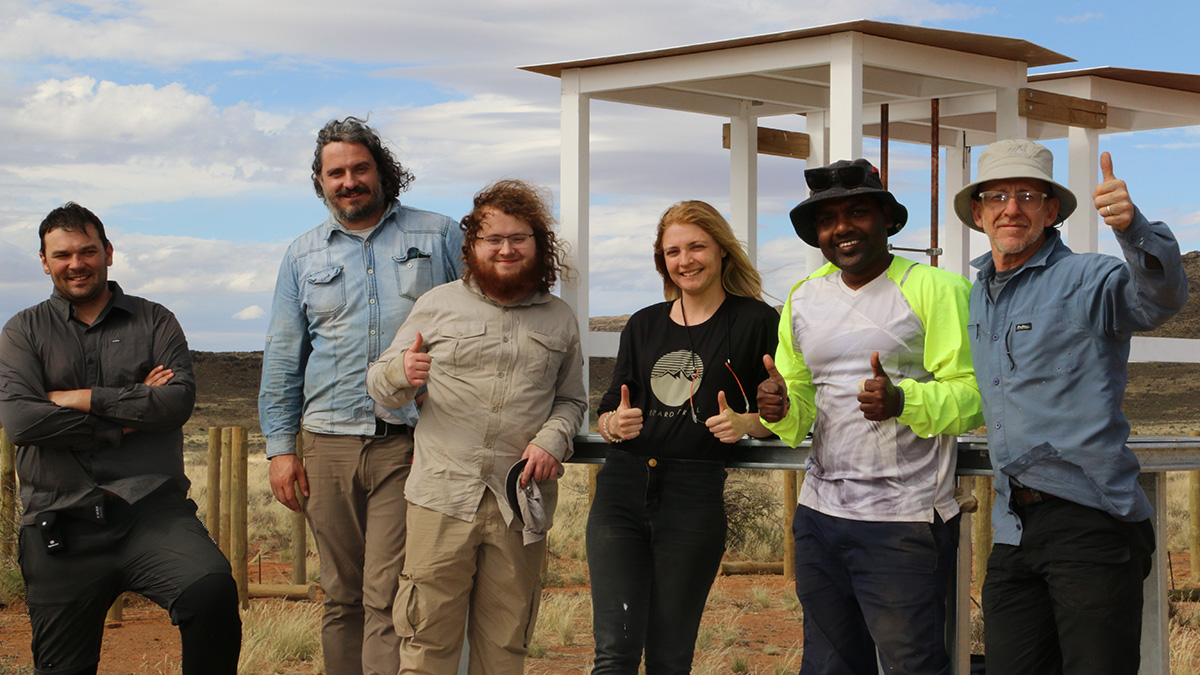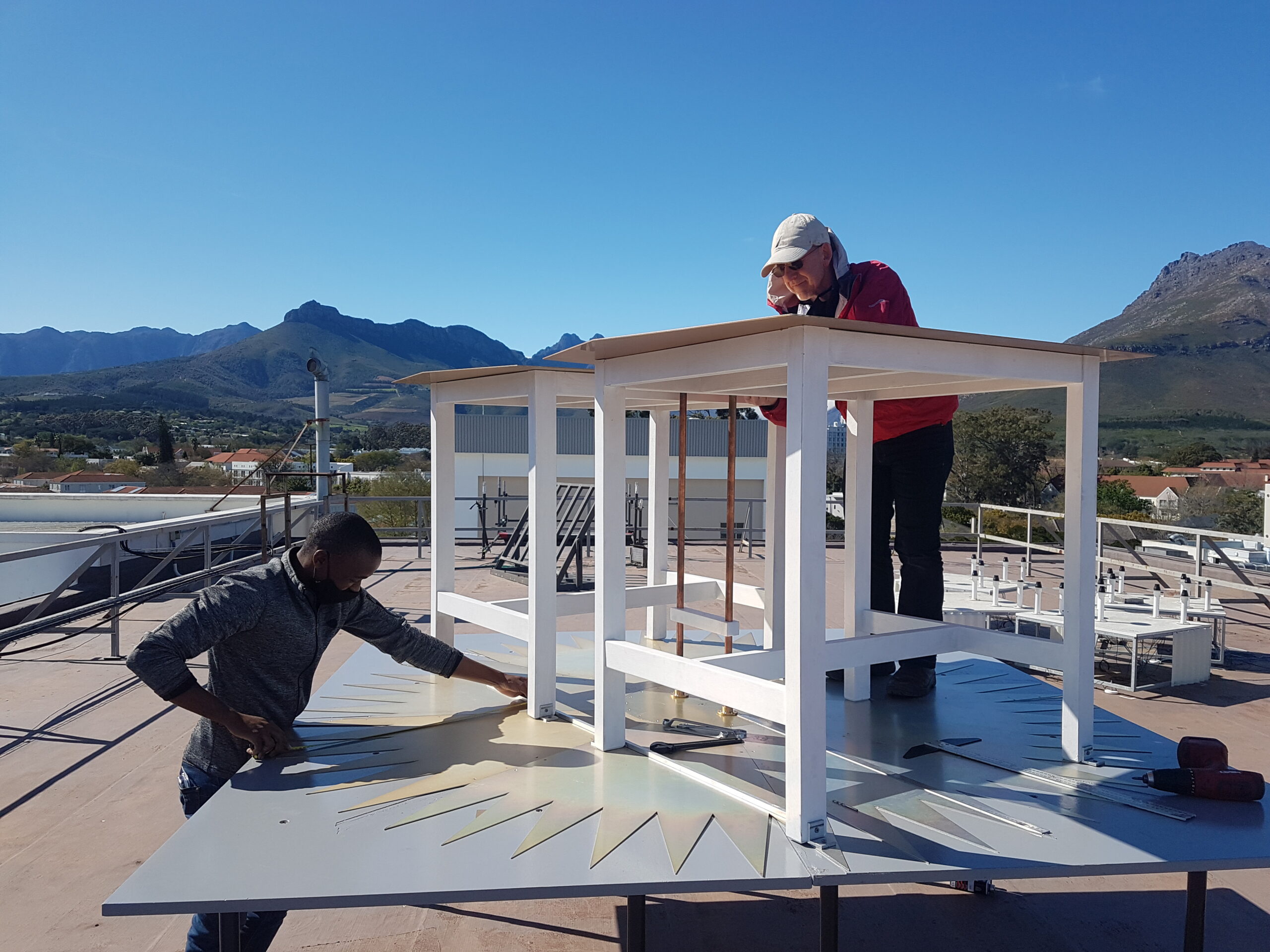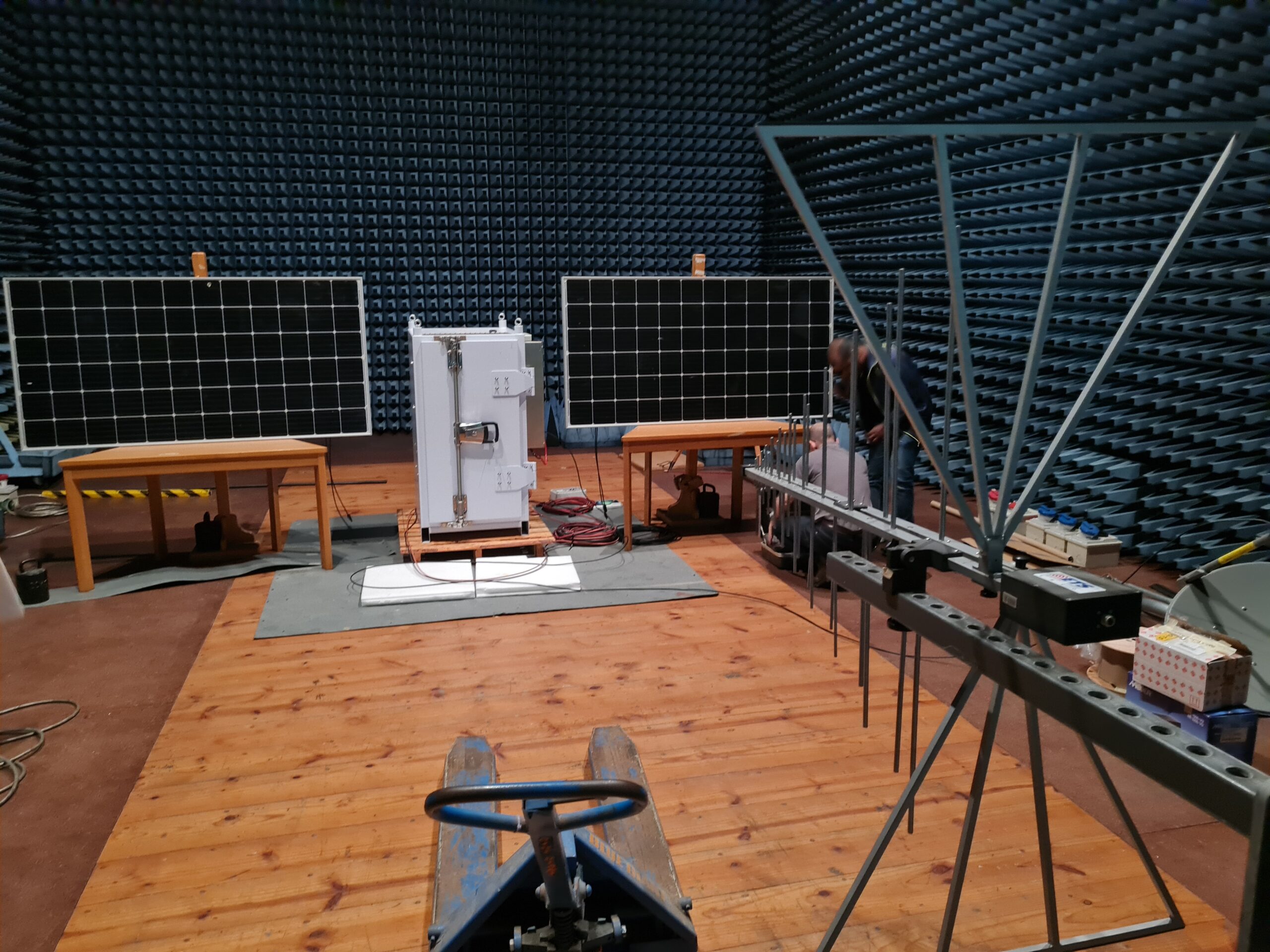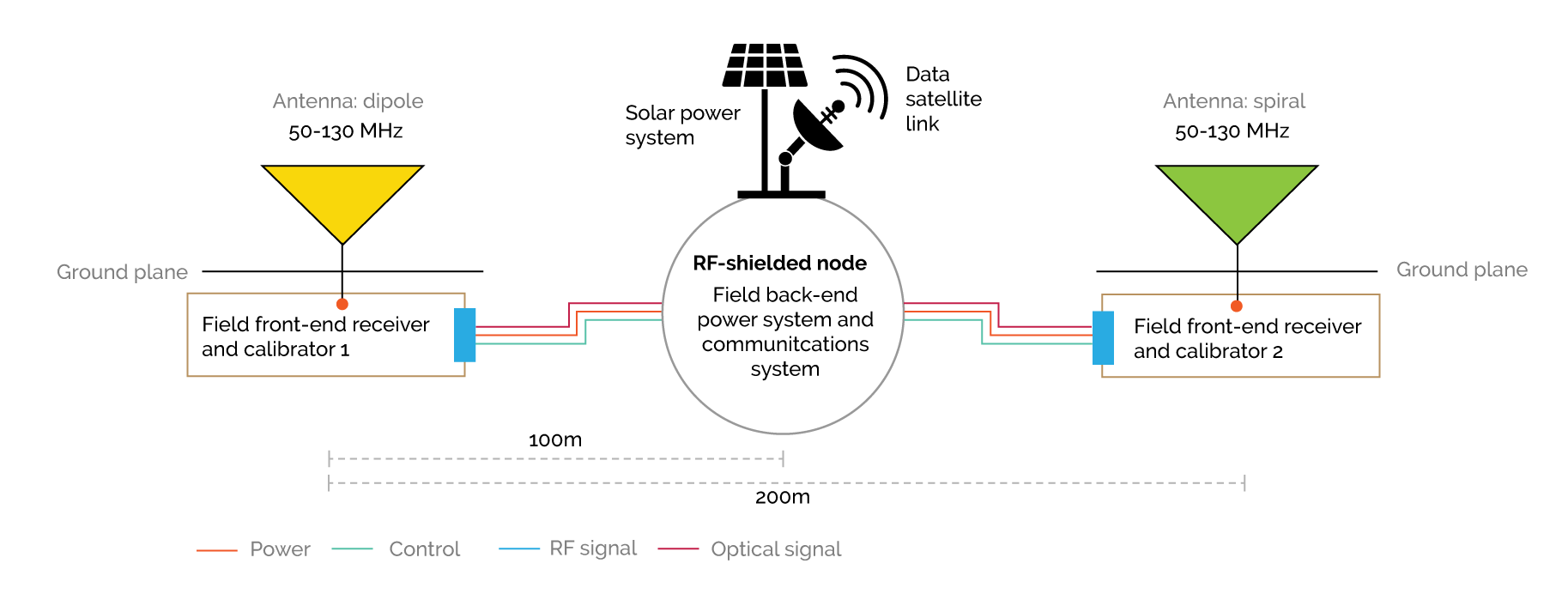REACH-ing beyond the stars
Engela Duvenage

Some of the REACH team members after the on-site installation of the prototype antenna in the Karoo in February 2022, from left to right: Prof Eloy de Lera Acedo, Prof Dirk de Villiers, Domic Anstey, Carla Pieterse, Dr Saurabh Pegwal, and Wessel Crouwkamp | Photo courtesy of the REACH project
Stellenbosch University (SU) and Cambridge University are leading the Radio Experiment for the Analysis of the Cosmic Hydrogen (REACH) project.
This project is to be put into operation in 2023 in the Northern Cape’s Karoo Radio Astronomy Reserve, which is already home to the Hydrogen Epoch of Reionization Array (HERA), the MeerKAT, and the first antennas of the Square Kilometre Array (SKA)1-Mid experiments.
The project aims to help determine how the first luminous objects in the sky formed, and in what manner they subsequently shaped the universe.
A team effort
The two principal investigators in this collaborative project are Prof Dirk de Villiers, SARChI Research Chair in Antenna Systems for the SKA in the Department of Electrical and Electronic Engineering at SU, and Prof Eloy de Lera Acedo of the Cavendish Astrophysics Group at Cambridge University in the United Kingdom.
The design work behind the 2,5-metre-tall REACH unit was initially done by De Villiers and a former postdoctoral associate, Dr Brandt Klopper. With input from the two principal investigators, the design was then finalised by Dr John Cumner as part of his PhD studies at Cambridge University.
The entire antenna was built by SU technicians and was proudly displayed for a few weeks on the roof of the SU Engineering Building.
The receiver and back-end processing node were designed and built at Cambridge University before being shipped to South Africa. Once assembled, the equipment was put through its paces at local company Spaceteq’s Houwteq Facility near Elgin to ensure that it does not cause any electromagnetic interference with equipment already in use in the Northern Cape’s radio-quiet reserve.
A design like no other
To the untrained eye, the design of the REACH Phase 1 field system might resemble that of a side table standing on top of a large fence. It is, however, an independent solar-powered radiometer with a hexagonal dipole antenna. The antenna is placed atop a large 20x20-metre elevated ground mesh, and the antenna plates are supported by a wooden structure. The ground mesh acts as a reflector behind the antenna to direct incoming cosmic signals towards it, and to shield the system from the effects of the ground.“Solid metal plates are used as the ground plane in the vicinity of the antenna to ensure excellent reflectivity, but also to shield the sensitive receiver box from the harsh Karoo sun. The receiver is placed as close as possible to the antenna terminals to minimise losses, and must be kept at a near-constant temperature to ensure proper calibration of the electronics,” De Villiers explains.

SU technicians Mpho (Gift) Lecholo and Wessel Crouwkamp assembling the first full-scale REACH prototype antenna on the roof of the Department of Electrical and Electronic Engineering in September 2020 | Photo courtesy of the REACH project

Researchers marking the exact spot, in January 2020, where the first REACH antenna will be erected. Pictured are, from left to right: Wessel Crouwkamp, Prof Dirk de Villiers, Alec Josaitis, and Prof Eloy de Lera Acedo. | Photo courtesy of the REACH project

The REACH system being tested for electromagnetic interference certification at HouwTeq by SU’s Wessel Crouwkamp and Saurabh Pegwal in November 2022 | Photo courtesy of the REACH project
Preventing interference
De Villiers describes the prevention of interference with existing equipment as a rigorous part of commissioning REACH: “All electronic devices must comply with regulations around how much radiation they are allowed to emit. You’ll notice SABS [South African Bureau of Standards] stickers about this on almost anything you buy.
“These regulations are, of course, much stricter for devices operating within the radio-quiet reserve where the SKA and other radio telescopes are hosted, to ensure that the different instruments do not interfere with one another. All electronics must therefore be carefully shielded to suppress all the spurious radiation.”
To this end, the South African Radio Astronomy Observatory (SARAO) performed rigorous compliance testing before it issued an electromagnetic interference (EMI) compliance certificate for the REACH antenna.
“Without this certificate, you cannot bring a device onto the site, never mind install it there permanently,” De Villiers explains.
Dr Saurabh Pegwall, a postdoctoral researcher in SU’s Department of Electrical and Electronic Engineering, is now tasked with ensuring that all technical aspects are in place to ensure the proverbial "lift-off" of the system. This includes verifying that the groundwork is done and that aspects such as the provision of solar power, internet services, and cabling are all in place. Pegwall will also be in charge of the installation, testing, and qualification of the equipment, which will hopefully be in 2023 still.
Later stages in the project could see scaled-up versions of the Phase 1 antenna, or even complementary antenna systems sensitive to other polarisations of the sky radiation.

The science behind REACH
REACH is one of many interconnected projects currently underway to give astronomers greater insight into the development of the early universe.Its antenna will function between the low frequencies of 50 and 130 MHz in an effort to detect and analyse redshifted radio emission and absorption from the so-called “21-centimetre line”. (The hyperfine transition of neutral hydrogen has a rest-frame wavelength of 21 centimetr
By making observations at low radio frequencies, researchers are able to directly study hydrogen in the gas clouds that provided the raw material for the formation of the first luminous cosmic structures during the earliest epochs of the universe.
According to the REACH webpage, these first luminous objects helped shape the universe some 0,35 to 1 billion years ago, between its initial evolution (commonly referred to as the "Big Bang") and the development and appearance of stars and other celestial objects.
The project is also a double-checking exercise of sorts. A paper published in Nature in 2022 summarises why: “Observations of the 21-cm line from primordial hydrogen promise to be one of the best tools to study the early epochs of the Universe: the dark ages, the cosmic dawn and the subsequent epoch of reionization. In 2018, the Experiment to Detect the Global Epoch of Reionization Signature (EDGES) caught the attention of the cosmology community with a potential detection of an absorption feature in the sky-averaged radio spectrum centred at 78 MHz. The feature is deeper than expected, and, if confirmed, would call for new physics. However, different groups have re-analysed the EDGES data and questioned the reliability of the signal.”
As such, the REACH team hopes to shed light on whether the initial EDGES data is trustworthy, or whether these signals from early space were, in fact, merely the result of instrumental uncertainty or environmental influences.
The first REACH antenna will be erected near Carnarvon in the Northern Cape.

The research initiatives reported on above are geared towards addressing the United Nations’ Sustainable Development Goals number 9 and 17 and goal number 2 of the African Union’s Agenda 2063.